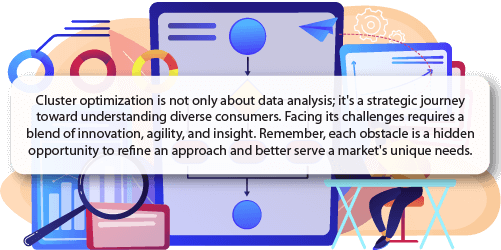In the fast-paced world of retail, cluster optimization emerges as a critical strategy for tailoring offerings to diverse customer segments. However, retailers face myriad challenges, from integrating cutting-edge technologies to adapting to rapid market changes, all while balancing localization with scalability. Overcoming these hurdles is essential for retailers aiming to enhance operational efficiency and meet the ever-evolving demands of their customer base.

Understanding the 'Why' behind cluster analysis and optimization reveals its pivotal role in retail success. By effectively clustering stores, retailers can unlock personalized customer experiences, optimize inventory, and enhance marketing strategies. This not only boosts customer satisfaction but also drives sales, making the mastery of cluster analysis and retail cluster strategy a non-negotiable element in the quest for retail dominance and sustainability in a competitive landscape.
Achieving excellence in cluster optimization involves navigating through complex challenges, from ensuring data accuracy to leveraging technological innovations and managing rapid market shifts. By adopting strategic approaches and embracing continuous improvement, retailers can enhance the customer experience, making it more personalized and satisfying. This journey requires a deep dive into the intricacies of each challenge, uncovering the keys to unlocking the full potential of retail clustering.

Inaccurate data collection and analysis
The strategic process of cluster analysis is pivotal for tailoring product assortments, marketing efforts, and overall store experiences to meet the diverse needs of various customer segments. This intricate task relies heavily on precise customer segmentation analysis, a core component of any retail cluster strategy.
However, the foundation of any successful cluster optimization effort lies in the accuracy and relevance of the data collected and analyzed. Without high-quality data, retailers risk making misinformed decisions that can lead to inefficiencies, lost sales, and diminished customer satisfaction.
The importance of advanced analytics and big data technologies
Advanced analytics and big data technologies have revolutionized how retailers collect, process, and interpret vast amounts of data.
For example, Walmart leverages big data to optimize its product assortment and inventory levels in different regions. By analyzing purchase history, customer demographics, and even weather patterns, Walmart can tailor its offerings to meet local demands.
These technologies enable retailers to identify patterns, trends, and correlations that might not be visible through traditional analysis methods, providing a comprehensive view of customer behavior and preferences within the framework of store clustering techniques.
Strategies for improving data collection methods
Enhancing data collection methods is crucial for obtaining a complete and accurate picture of the retail landscape.
One effective strategy is integrating omnichannel data collection, gathering information across all customer touchpoints, including in-store purchases, online transactions, and social media interactions.
For example, Nordstrom tracks customer interactions across online and offline channels to create a unified customer profile, which informs its cluster optimization strategies by highlighting preferences and behaviors specific to different customer groups.
Another strategy involves using customer feedback and engagement tools, such as surveys, feedback kiosks, and interactive mobile apps, to gather direct insights from consumers. This direct feedback can provide valuable qualitative data that complements quantitative data from sales and inventory, offering a more nuanced view of customer needs and preferences.
Techniques for ensuring data quality and relevance
Ensuring the quality and relevance of data is paramount for effective cluster optimization. Retailers can adopt several techniques to achieve this goal.
Data cleansing and validation processes are essential to remove inaccuracies, duplicate entries, and outdated information. It also ensures that any analysis uses current and correct data.
Another technique involves the continuous updating and enrichment of data sets. Retailers can enhance their data's relevance by incorporating external data sources, such as market research and economic indicators, to adjust their clustering strategies in response to external changes.
This dynamic approach is a cornerstone of an effective retail cluster strategy, ensuring a personalized and satisfying shopping experience for all customers.

Adapting to rapid market changes
The retail landscape is continuously evolving, driven by shifts in consumer preferences, technological advancements, and broader market dynamics.
For retailers, adapting swiftly to these changes is crucial for maintaining competitiveness and relevance. Cluster optimization is vital in this adaptability, enabling retailers to adjust their strategies to align with current market conditions.
Continuous monitoring of market trends
Staying ahead of market trends necessitates a proactive approach to monitoring and analysis.
Retail giants like Amazon exemplify this approach by leveraging their vast data capabilities to track changes in consumer behavior in real-time.
They utilize sophisticated algorithms to analyze search trends, purchase history, and customer reviews, allowing them to anticipate shifts in consumer interests and adjust their product offerings and recommendations accordingly.
Continuous monitoring extends beyond digital analytics. Zara, a leading fashion retailer, has mastered the art of rapid response to fashion trends. By closely watching fashion shows, listening on social media, and reading customer feedback, Zara can swiftly introduce new designs to the market, often within weeks. This agility ensures offerings consistently match current consumer preferences.
Flexible cluster optimization models
Flexibility in cluster optimization models is essential for retailers to quickly adapt to changing market conditions. Retailers can achieve that through dynamic clustering algorithms that adjust cluster characteristics based on ongoing data analysis.
For example, H&M uses data from sales, social media, and online interactions to adjust its product offerings and marketing strategies across different regions. This approach allows them to quickly capitalize on emerging trends and minimize the impact of forecast errors, a testament to the effectiveness of an adaptive and flexible retail cluster strategy.
Implementing flexible models also involves embracing a test-and-learn approach. Retailers like Starbucks frequently experiment with new product offerings, store formats, and marketing campaigns in specific clusters before rolling them out more broadly. This strategy enables them to evaluate the effectiveness of their adaptations in real-time and make informed decisions based on actual performance data.
In a rapidly changing retail environment, adapting quickly to market shifts is more critical than ever. Retailers that excel in this area continuously monitor market trends and implement flexible cluster optimization models, enabling them to stay aligned with consumer preferences and market dynamics.
By adopting these strategies, retailers can remain agile, responsive, and competitive when facing constant change.

Balancing localization with scalability
Achieving a balance between localization and scalability is a complex yet critical challenge. Retailers must strive to cater to the unique preferences of different customer clusters through localized product assortments and marketing efforts, while also seeking to maintain operational efficiency and scalability across their entire network.
This delicate balance requires strategic planning, technological leverage, and operational agility, all of which embody the essence of an effective retail cluster strategy.
Scalable localization strategies
One successful example of scalable localization is McDonald's. The global fast-food chain expertly tailors its menu to accommodate local tastes and dietary habits in various countries while maintaining its core product offerings.
For example, in India, McDonald's offers vegetarian options and unique local flavors, which cater to the country's dietary practices and preferences. This approach allows McDonald's to resonate with local consumers without compromising the efficiency and scalability of its global operations.
Another example is Ikea, the Swedish furniture giant known for its cost-effective, flat-pack furniture. Ikea adapts its product designs to reflect local living conditions and consumer preferences.
For example, in Japan, IKEA designed ranges that take into account the limited space of urban households, while those in other countries might showcase larger furniture pieces. Ikea's ability to localize its offerings, while benefiting from economies of scale in production and distribution, exemplifies scalable localization in action.
Leveraging technology for balance
Technology plays a pivotal role in managing the balance between customization and standardization. Advanced analytics, artificial intelligence, and machine learning algorithms can analyze vast amounts of data to identify customer preferences within different clusters.
For example, H&M uses AI-driven demand forecasting to tailor its product assortments and promotional strategies locally, ensuring that each store's offerings align with the preferences of its surrounding community. This technological approach enables Target to achieve a high degree of localization while maintaining operational efficiencies across its vast store network.
Operational adjustments for efficient scalability
Operational adjustments are crucial for retailers looking to scale their localization efforts efficiently. This can involve modular store layouts and inventory management systems that can be easily adapted to different market needs without extensive overhaul.
Balancing localization with scalability is essential for retailers aiming to meet the diverse needs of their customer base without compromising operational efficiency. Retailers can achieve this balance by strategically using scalable localization strategies, leveraging technology, and making operational adjustments.

Integrating advanced technologies
The retail industry is transforming, driven by integrating advanced technologies into traditional retail operations. This integration is pivotal for enhancing cluster optimization, enabling retailers to understand and serve their diverse customer segments.
However, the challenge lies in seamlessly incorporating these technologies into existing systems without disrupting operations while addressing employee skills gaps.
Cutting-edge technologies in retail cluster optimization
Several cutting-edge technologies are reshaping how retailers optimize their store clusters.
For example, Artificial Intelligence (AI) and Machine Learning (ML) are at the forefront, offering predictive analytics that help retailers forecast demand, personalize marketing efforts, and optimize inventory levels for each cluster.
The Kroger Co., a leading supermarket chain, uses AI and ML to analyze customer data and optimize product assortments and promotional offers, ensuring that each store caters to the unique preferences of its local customer base.
Big data analytics is another vital technology that enables retailers to process vast amounts of transactional, customer, and market data to uncover insights into customer behavior and preferences. Walmart, for example, leverages big data to optimize its supply chain and inventory management, ensuring that products are available where and when customers need them.
Internet of Things (IoT) technology also plays a crucial role in enhancing customer experiences and operational efficiency. Smart shelves, equipped with IoT sensors, can track inventory levels in real-time, helping retailers maintain optimal stock levels and minimize out-of-stock incidents. Walmart, for example, uses IoT to track goods through its supply chain.
Best practices for technology integration
Successfully integrating new technologies into existing systems requires a strategic approach. One best practice is to adopt a phased rollout, starting with pilot programs in select stores to test and refine the technology before broader implementation. This approach allows retailers to minimize disruptions and gather valuable feedback.
Collaboration between IT and operational teams is also crucial to align technological solutions with business needs and can integrate into existing workflows without issue. Regular communication and planning sessions can facilitate this alignment.
Addressing the skills gap and training
The rapid adoption of advanced technologies necessitates upskilling and reskilling of the workforce. Retailers must invest in comprehensive training programs to equip their employees with the necessary skills to operate new systems and technologies.
For example, Lowe's introduced the Lowe's University Training Center - also known as Lowe's U - to train its employees on emerging technologies, ensuring they are well-prepared to leverage these tools in enhancing customer service and operational efficiency.
Integrating advanced technologies into retail operations offers tremendous potential for enhancing cluster optimization. By leveraging AI, ML, big data analytics, and IoT, retailers can gain deeper insights into customer preferences and optimize their operations accordingly.
However, adopting these technologies requires careful planning, a phased approach to integration, and a commitment to employee training. Retailers who navigate these challenges effectively can significantly enhance their competitive edge.
Conclusion
By mastering retail cluster strategy and customer segmentation, retailers can adeptly navigate cluster optimization challenges, enhancing efficiency and personalization. Discover how our DotActiv solution empowers this journey. Embrace the future of retailing with a free 14-day trial of DotActiv Enterprise and unlock the potential of strategic clustering and segmentation today.


